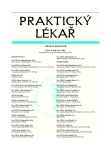Evolution and evolutionary theory for physicians.
IV. Life on Earth
Authors:
F. Koukolík
Authors‘ workplace:
Primář: MUDr. František Koukolík, DrSc.
; Národní referenční laboratoř prionových chorob
; Fakultní Thomayerova nemocnice s poliklinikou, Praha
; Oddělení patologie a molekulární medicíny
Published in:
Prakt. Lék. 2010; 90(4): 199-205
Category:
Editorial
Overview
The oldest organisms on Earth are prokaryotes. There are many differences between them and eukaryotes. Four models explain the origin of eukaryotes:
– fusion of an archea and bacteria, and
– three variants of endosymbiosis.
The current model classifies eukaryotes into six supergroups. Most people will be surprised to discover that they belong in the same supergroup as the sponges. In some well-known cases, molecular methods for estimating age on the “tree of life” give results that are about twice as old as the oldest fossils. The Ediacara hills in South Australia (formed in the geological epoch 635–542 million years ago) and Burgess Shale in the Canaadian Rockies are key sources for our observation of the earliest animal fossils. The renowned “Cambrian explosion” may have been to a certain extent an artefact. Questions concerning the evolution of plants, e.g. evolution of photosynthesis and multicellularity and the developmental genetic changes responsible for the origin of innovations such as roots, leaves and vascular tissue may be answered by comparative genomics as more plant genome sequences became available.
Key words:
prokaryotes, eukaryotes, animal evolution, plant evolution.
Sources
1. Baldauf, S.L. The deep roots of eukaryotes. Science, 2003, 300, p. 1703-1706.
2. Benton, M.J., Ayala, F.J. Dating the tree of life. Science, 2003, 300, p. 1698-1700.
3. Benton, M.J., Donoghue, P.C.J. Paleontological evidence to date the tree of life. Mol. Biol. Evol. 2007, 24, p. 26-53.
4. Bowman, J.L., Floyd, S.K., Sakakibara, K. Green genes - comparative genomics of green branch of life. Cell 2007, 129, p. 29-234.
5. Brown, J.R. Ancient horizontal gene transfer. Nature Reviews Genetics 2003, 4, p. 121-132.
6. Budd, G.E. The earliest fossil record of the animals and its significance. Phil. Trans. R. Soc. B. 2008, 363, p. 1425-1434.
7. Burgess Shale [on-line]. Dostupné na http://en.wikipedia.org/wiki/Burgess_Shale.
8. Dennett, D. The new replicators. In: Pagel M. Encyclopedia of evolution. Oxford: Oxford University Press, 2002.
9. Donoghue, P.C.J., Benton, M.J. Rocks and clocks: calibrating the Tree of life using fossils and molecules. Trends Ecol. Evol. 2007, 22, p. 424-431.
10. Doolitle, W.F., Bapteste, E. Pattern pluralism and the Tree of life hypothesis. Proc. Natl. Acad. Sci. 2007, 104, p. 2043-2049.
11. Ediacaran period [on-line]. Dostupné na http://en.wikipedia.org/wiki/Ediacaran.
12. Encyclopedia of Life [on-line]. Dostupné na http://www.eol.org.
13. Fukami-Kobayashi, K., Minezaki, Y., Tateno, Y. et al. A tree of life based on protein domain organizations. Mol. Biol. Evol. 2007, 24, p. 1181-1189.
14. Maddison, D.R., Schulz, K-S., Maddison, W.P. The tree of life web project. Zootaxa 2007, 1168, p. 19-40.
15. Martin, W., Rujan, T., Richly, E. et al. Evolutionary analysis of Arabidopsis, cyanobacterial, and chloroplast genomes reveals plastid phylogeny and thousands of cyanobacterial genes in the nucleus. Proc. Natl. Acad. Sci. USA, 2002, 99, p. 12246-12251
16 begin_of_the_skype_highlighting 12246-12251 16 end_of_the_skype_highlighting. Lane, C.H.E., Archibald, J.M. The eukaryotic tree of life: endosymbiosis takes its ToL. Trends Ecol. Evol., 2008, 23, p. 268-275.
17. Lenski, R.E., Ofria, Ch., Pennock, R.T. et al. The evolutionary origin of complex features. Nature 2003, 423, p. 139-144.
18. Mayr, E. What evolution is. New York: Basic Books, 2001.
19. Oren, A., Papke, R.T. Molecular phylogeny of microorganisms. Norfolk: Caister Academic Press, 2010.
20. Poole, A.M., Penny, D. Evaluating hypothese for the origin of eucaryotes. BioEssays 2006, 29, p. 74-84.
21. Shapiro, J.A. Thinking about bacterial populations as a multicellular organisms. Annu. Rev. Microbiol. 1998, 52, p. 81-104.
22. Tree of Life [on-line]. Dostupné na http://tolweb.org/tree/.
23. Woese, C.R., Kandler, O., Wheelis, M.L. Toward natural system of organisms: proposal for the domains Archea, Bacteria and Eucarya. Proc. Natl. Acad. Sci. USA, 1990, 87, p. 4576-4579.
24. Woese, C.R. The universal ancestor. Proc. Natl. Acad. Sci. USA, 1998, 95, p. 6854-6859.
25. Zimmer, C. Origins. On the origin of eukaryotes. Science 2009, 325, p. 666-668.
Labels
General practitioner for children and adolescents General practitioner for adultsArticle was published in
General Practitioner

2010 Issue 4
Most read in this issue
- Myocarditis
- Subcutaneous traumatic rupture of the tibialis anterior tendon
- Occurrence of polycystic ovary syndrome and hyperadrogenemia in women with type 1 diabetes mellitus
- Heart failure with preserved systolic function of the left ventricle
